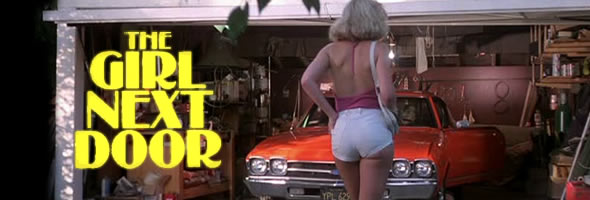

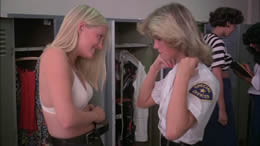 It's safe to say that no one else
It's safe to say that no one else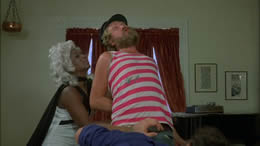 has ever had a career like that of actor James Hong, the indelible character actor who earned his cinematic immortality with hundreds of roles including the villainous Lo Pan in Big Trouble in Little China and ill-fated Chew in Blade Runner (not to mention the voice of Po's adopted dad in the Kung Fu Panda films). If that all sounds pretty mainstream, well, he also directed a few films on the side starting off with a pretty raunchy softcore Rene Bond film in 1973, Hot Connections. Six years later he followed that up with the teen sex comedy under discussion here, The Girl Next Door, which was issued under a multitude of titles over the years like Police Academy Girls, High School Teasers, and most famously on VHS from Vestron as Teen Lust. Even more confusingly, one of the trailers and some of the ad art refer to it as The Girls Next Door. In any case, what might seem like your average Porky's imitation is a lot more fascinating when you consider that it came out about three years ahead of that craze, and it's still weird enough to stand out from its jiggling peers.
has ever had a career like that of actor James Hong, the indelible character actor who earned his cinematic immortality with hundreds of roles including the villainous Lo Pan in Big Trouble in Little China and ill-fated Chew in Blade Runner (not to mention the voice of Po's adopted dad in the Kung Fu Panda films). If that all sounds pretty mainstream, well, he also directed a few films on the side starting off with a pretty raunchy softcore Rene Bond film in 1973, Hot Connections. Six years later he followed that up with the teen sex comedy under discussion here, The Girl Next Door, which was issued under a multitude of titles over the years like Police Academy Girls, High School Teasers, and most famously on VHS from Vestron as Teen Lust. Even more confusingly, one of the trailers and some of the ad art refer to it as The Girls Next Door. In any case, what might seem like your average Porky's imitation is a lot more fascinating when you consider that it came out about three years ahead of that craze, and it's still weird enough to stand out from its jiggling peers.
The "plot" revolves around a group of teenagers who are all interested in getting in each other's pants, even when they're sitting around watching silly home movies of each other. DeDe (Barnes) will pop her 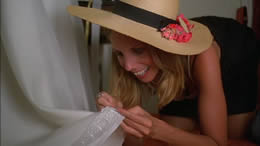 top at the drop of a hat to get back with her ex, Terry (Lang), whose nice girlfriend, Carol (Friday the 13th Part 2's Baker), is busy in a police training program after school with her best pal Neeley (Cederquist). This proves to be the springboard for a string of barely connected vignettes involving a prostitution sting operation, a mentally incapacitated guy next door, pie fights, cross dressing, home invasion, a gay priest, attempted gang rape by little leaguers, and a wedding that seems to be heading for disaster.
top at the drop of a hat to get back with her ex, Terry (Lang), whose nice girlfriend, Carol (Friday the 13th Part 2's Baker), is busy in a police training program after school with her best pal Neeley (Cederquist). This proves to be the springboard for a string of barely connected vignettes involving a prostitution sting operation, a mentally incapacitated guy next door, pie fights, cross dressing, home invasion, a gay priest, attempted gang rape by little leaguers, and a wedding that seems to be heading for disaster. 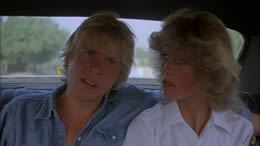
As mentioned above, a large part of the fascination in this film is observing how it marks something of a crossroads between the fluffy T&A comedies of the '70s (such as the same year's Gas Pump Girls) and the bawdy adolescent comedies of the '80s. You can also pinpoint this shift with the 1978 Israeli film Lemon Popsicle (which was itself remade as The Last American Virgin) and its sequels, which share the structural looseness found here. By any sort of critical standards, this isn't a particularly good film; it feels like arbitrary script pages were being thrown at the actors a few minutes before shooting, and the mostly green cast exhibits more enthusiasm than acting chops. However, it manages to make up for that with sheer arbitrary, sometimes nasty weirdness including numerous gags that would never pass the politically correct standards of today. (The ending almost feels like a precursor to Tie Me Up! Tie Me Down!) On top of that, you get to see a few familiar faces like busy exploitation character actor George "Buck" Flower (hiding under a pseudonym, presumably for union reasons) and a young Perry Lang, who went on to appear in films like 1941, 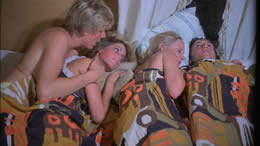 Alligator, and The Hearse before becoming a TV director.
Alligator, and The Hearse before becoming a TV director.
The Code Red release of The Girl Next Door contains both the 77-minute "director's cut" and the 86-minute Teen Lust version, though exactly why two different versions were prepared is never really addressed on the commentary track. Appearing on that chat track are Hong (who is hilarious), Marc Edward Heuck, and the label's Bill Olsen, who cover pretty much everything else you could want to know about the film including the stories behind the cast members (many using assumed names), their discomfort with shooting some scenes (including Lang's early pants-dropping gag), the misfortune of releasing this a couple of years too early, and the differences between the two cuts. The commentary was recorded for the Teen Lust cut (taken from a worn but okay 35mm print), incidentally, which has several extended dialogue scenes and a slightly extended ended, among other differences. On the other hand, the Girl Next Door version (much more pristine and transferred from the negative) contains a longer opening sequence with full main titles, better editing, and improved end credits with a theme song. You won't find a real substantive difference between the two, but the variations are definitely interesting. Also included are two trailers with different variations of the Next Door title.
![]()